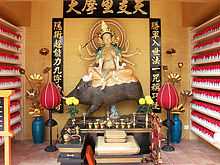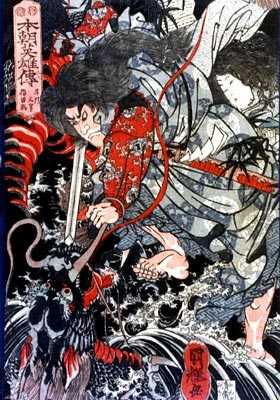Marici (Buddhism)

In Mahayana and Vajrayana Buddhism, Marici is a deva or bodhisattva associated with light and the sun. She is known as Molizhitian (摩利支天) or Molizhitian Pusa (摩利支天菩萨) in China and Marishi-ten (摩利支天) in Japan and in Tibetan as 'Odzer Canma, "Woman Endowed with Rays of Light" (Wylie: 'od zer can ma ). She is one of the Twenty (or Twenty Four) Celestials (二十/二十四諸天). In Taoism, Marici is known under the epithet of the Dipper Mother (Chinese: 斗母元君; pinyin: Dǒumǔ Yuánjūn), a name also used by Buddhists.
Iconography
Marici is usually depicted in one of the following ways:
- As a beautiful woman on an open lotus, the lotus itself sometimes perched on the back of seven sows.
- As a ferocious wrathful deity perched on the back of a boar.
- Riding a fiery chariot pulled by seven savage boars or sows.
- As a multi-armed woman with a different weapon in each hand standing or sitting on the back of a boar.
She has been depicted with one, three, five or six faces and two, six, eight, ten or twelve arms; three eyes; in her many-faced manifestations one of her faces is that of a sow.
Origins
The origins of Marici are obscure; however, she appears to be an amalgamation of Indic, Iranian and non-Indo-Iranian[1] antecedents spanning 1500 years.
Region
China

Marici in China is worshiped as both a Buddhist and Taoist deity. She is highly revered in Esoteric Buddhism. Most often, she is depicted with three eyes in each of her four faces; with four arms on each side of her body. Two of her hands are held together, and the other six hold a sun, moon, bell, golden seal, bow, and halberd. She is either standing/sitting on top of a lotus or pig, or on a Lotus on top of seven pigs. She is celebrated on the 9th day of the 9th lunar month.
Due to similar iconography, she is often confused with the Bodhisattva Cundī. Among Chinese Buddhists, she is worshiped as the goddess of light and as the guardian of all nations, whom she protects from the fury of war. [2]
In Taoism, Dou Mu remains a popular deity and is often referred to as Queen of Heaven (Chinese: 天后; pinyin: Tiān Hòu) and is widely worshiped as the Goddess of Beidou (the Chinese equivalent of Ursa Major except that it also includes 2 "attendant" stars). She is also revered as the mother of the Nine Emperor Gods who are represented by the nine stars in the Beidou constellation.[3] Legend has it that one spring day a queen went to bath in a pond. Upon entering she suddenly felt "moved" and nine lotus buds rose from the pond. Each of these lotus buds opened to reveal a star which then became the Beidou constellation.
She is worshiped today in Taoist temples like the White Cloud Temple and the Tou Mu Kung Temple which has both Taoist and Buddhist influences.
Japan

An important deity in the Shingon and Tendai schools, Marici was adopted by the Bujin or Samurai in the 8th century CE as a protector and patron.
While devotions to Marici predate Zen, they appear to be geared towards a similar meditative mode in order to enable the warrior to achieve a more heightened spiritual level. He lost interest in the issues of victory or defeat (or life and death), thus transcending to level where he became so empowered that he was freed from his own grasp on mortality. The end result was that he became a better warrior.
The worship of Marici was to provide a way to achieve selflessness and compassion through Buddhist training by incorporating a passion for the mastery of the self. Some martial arts schools also worshipped Marishi-Ten as a guardian deity of there teachings.
Famous exemple is the school of Tenshin Shōden Katori Shinto-ryū whose blood pledge chart (Keppan) ordered the disciples to submit to Futsunushi-no-mikoto and Marishi-Ten's punishment if they commit sin against the school's rule (or rather the God of Katori's holy commandment).
But, the most outstanding exemple is by far the worship of Marici by the Yagyū Shinkage-ryū. In the aftermath of the battle of Sekigahara, Tokugawa Ieyasu made the vow to protect this style and the Yagyū family in exchange for there teachings. The pledge was sign under Marishi-Ten's guarantee, and since then, Shinkage style has been permeated with Mikkyō (esoteric Buddhism), mantra and mudra who are said to confer invisibility upon a warrior, if properly performed.
The famous Yagyū Renya wrote at a mere 12 or 13 years old the Shinkage-ryū Heihō Mokuroku Renya kudensho (scroll of Renya's oral teachings about the Art of War according to the style of the New-Shadow), treasured scroll discussing about the theory and techniques of the first and second Sōke compared to the one of his father, the Yagyū Shinkage-ryū 3rd sōke, Yagyū Toshitoshi. Indeed, martial arts were changing because samurai no longer fought wearing complete armors but instead with civilian clothes, so the headmaster made the choice to adapt to the current time. Also, it is known that Sekishūsai created the Mutō-dori techniques, which was absent from the original Shinkage-ryū of headmaster Kamiizumi, and which he demonstrated on the very person of the Shōgun Tokugawa Ieyasu himself !
The man known as Yagyū Renya was not a swordsman in name only, waiting for his monthly paycheck, as many other high ranked samurai of the Edo era were. Renya fully mastered the core principle of Shinkage-ryū, Marobashi, which allowed him a very famous martial prowess in Edo era. Attacked at night, Renya unsheated his wakizashi and butchered the assassin, killing him in a single blow. Therefore, this wakizashi forged by Hata Mitsuyo was nicknamed "Oni-hōchō", the demon's kitchen knife, and many copies of various quality were made by swordsmith of the time, with it's peculiar kata-shinogi-zukuri shape. Marobashi means a deep understanding of the nature of combat itself, in other words a fighting instinct non-existent as an innate state in human beings. Such was the man, Yagyū Renya, and his book was never showed to anyone, in fact he wrote on the cover that someone foolish enough to broke the seal would be blinded by Marishi-ten ! According to Renya's strong beliefs, the Kudensho was passed down only to Shinkage-ryū headmasters.
Samurai would invoke Marici at sunrise to achieve victory. Since Marici means "light" or mirage, she was invoked to escape the notice of one's enemies.
She was also later worshipped in the Edo period as a goddess of wealth and prosperity by the merchant class, alongside Daikoku-ten (大黒天) and Benzaiten (弁財天) as part of a trio of "three deities" (santen 三天).
As a Yaksha General
Marici has also sometimes included as one of the Twelve Heavenly Generals associated with Bhaiṣajyaguru, the Buddha of Medicine.
Images of her are common in India, but there are few examples in China and Japan.
See also
![]() Media related to Marici at Wikimedia Commons
Media related to Marici at Wikimedia Commons
- List of Solar Deities
- Lunar deity
- Marichi Thakurani
References
- ↑ Hall, David Avalon (1990). Marishiten: Buddhism and the warrior Goddess, Ph.D. dissertation, (Ann Arbor: University microfilms), p. 45.
- ↑ Keith Stevens (1997). Chinese Gods: The Unseen World of Spirits and Demons. Colins and Brown. p. 94. ISBN 1-85028-409-1.
- ↑ Keith Stevens (1997). Chinese Gods: The Unseen World of Spirits and Demons. Colins and Brown. p. 105. ISBN 1-85028-409-1.
Further reading
- Hall, David Avalon. (2013). The Buddhist Goddess MARISHITEN: A Study of the Evolution and Impact of Her Cult on the Japanese Warrior. Global International. ISBN 978-90-04-25010-9
- Hall, David Avalon. (1997). "Marishiten: Buddhist Influences on Combative Behavior" in Koryu Bujutsu: Classical Warrior Traditions of Japan. Koryu Books, pp. 87–119. ISBN 1-890536-04-0
External links
| ||||||||||||||||||||||||
| |||||||||||||||||||||||||||||||||||||||||||||
| |||||||||||||||||||||||||
| |||||||||||||||||||||||||||||||||
Taoist Pantheon
.svg.png)



